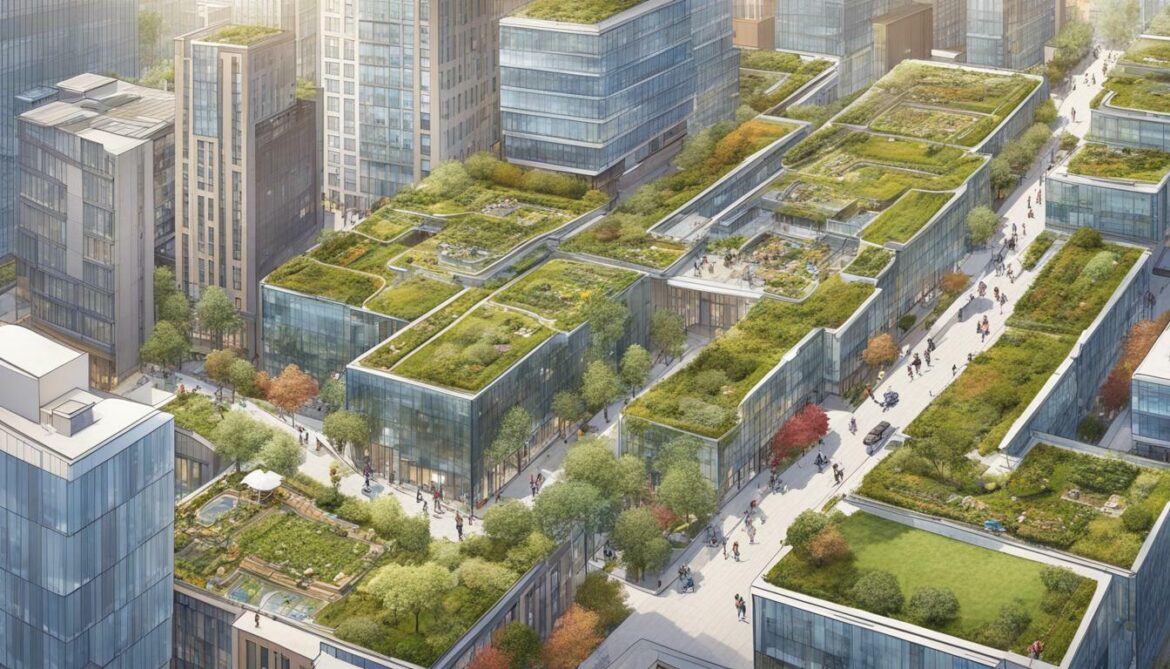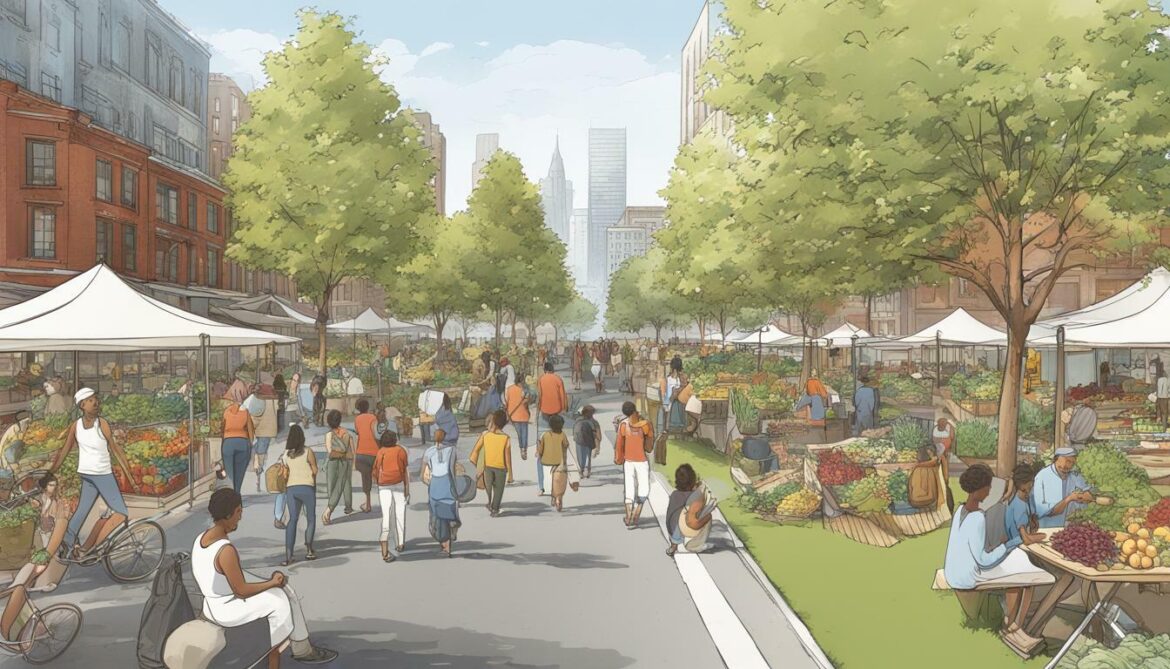As our cities continue to grow and expand, there has been a shift towards post-growth urban development that prioritizes well-being and sustainability. This marks a new era in urban planning, one that recognizes the importance of creating cities that are not only economically prosperous but also healthy and happy places to live.
With a growing awareness of the impact that our urban environments have on our physical and mental health, it has become increasingly clear that the wellbeing of city residents must be at the forefront of our urban development efforts. This means designing cities that are not only environmentally sustainable but also socially and economically inclusive.
Key Takeaways:
- Cities are shifting towards post-growth urban development that prioritizes well-being and sustainability.
- Creating cities that are healthy and happy places to live is essential for the wellbeing of city residents.
- Well-being-focused urban development means designing cities that are environmentally, socially and economically inclusive.
Defining Well-Being in Cities
Well-being is a holistic concept that encompasses physical, mental, and social health, as well as a sense of purpose and fulfilment in life. In the context of cities, well-being refers to the quality of life experienced by urban dwellers, which is influenced by a multitude of factors.
Access to green spaces, for instance, can promote physical activity and improve air quality, while also providing opportunities for relaxation and social interaction. Healthcare facilities and services are critical for ensuring that residents can access the care they need to maintain their health. Education and cultural institutions are essential for personal growth and community engagement, while affordable housing is a basic necessity for ensuring that everyone can live decently and without housing insecurity.
Many other factors contribute to the well-being of urban communities, including safety, access to healthy food, community cohesion, and economic opportunities. By addressing these factors, cities can create environments that support the physical, mental, and emotional health of their residents.
Defining Well-Being in Cities:
| Factor |
Explanation |
| Access to green spaces |
Provides opportunities for physical activity, relaxation, and social interaction, while improving air quality. |
| Healthcare facilities and services |
Ensure that residents can access care when they need it, promoting good health and preventing illness. |
| Education and cultural institutions |
Provide opportunities for personal growth, community engagement, and cultural enrichment. |
| Affordable housing |
Ensures that everyone can live decently and without housing insecurity. |
Other factors that contribute to well-being in cities include safety, access to healthy food, community cohesion, and economic opportunities. By addressing these factors, cities can create environments that support the physical, mental, and emotional health of their residents.

The Rise of Sustainable and Wellness-Friendly Cities
The trend towards sustainable and wellness-friendly cities is gaining momentum globally. Increasingly, city planners are realising the importance of creating urban environments that prioritise the well-being of its citizens, as well as the planet.
Sustainable cities are designed to minimise their carbon footprint by implementing innovative energy-saving measures, such as renewable energy initiatives, public transportation enhancements, and urban farms to produce locally-sourced food.
Wellness-friendly cities, on the other hand, focus on creating environments that promote physical and mental health. One of the core principles of wellness-friendly cities is walkability, which encourages citizens to walk or cycle rather than drive. This not only leads to a reduction in carbon emissions but also contributes to an overall healthier population. Additionally, wellness-friendly cities offer access to green spaces, community gardens, and recreational areas that encourage physical activity and social interaction.
One such innovative example of a sustainable and wellness-friendly city is Copenhagen in Denmark. Copenhagen has a goal of becoming carbon-neutral by 2025 and is well on its way to achieving this through the implementation of a world-class public transportation system and a focus on urban cycling. Copenhagen also boasts an abundance of green spaces, including the Tivoli Gardens park, which hosts a range of outdoor activities and events.

With the rise of sustainable and wellness-friendly cities, there is a growing understanding that urban development should not come at the expense of the well-being of citizens or the planet. Instead, cities that prioritise sustainability and wellness are finding that they can create healthier, happier communities while also reducing their environmental impact.
Key Factors for Well-Being in Cities
Creating urban environments that prioritize well-being requires addressing key factors that contribute to a healthy and thriving community. These factors include:
| Factor |
Importance |
| Clean air and water |
Access to clean air and water is essential for good health. Pollution can lead to respiratory issues, while poor water quality can cause illness. |
| Affordable housing |
Housing is a basic need, and when it is unaffordable, it can lead to homelessness, poverty, and stress. |
| Social inclusion |
A sense of belonging and connection to others is vital to mental health and overall well-being. Communities that promote social inclusion foster a sense of belonging and encourage greater participation in community life. |
| Cultural diversity |
Cultural diversity is an essential aspect of urban life, promoting tolerance, understanding, and creativity. |
| Access to recreational activities |
Recreational activities, such as sports, arts, and cultural events, can promote physical and mental health, reduce stress, and foster community engagement. |
Addressing these factors is essential for creating healthy and livable cities. However, it requires a multi-faceted approach that involves collaboration between residents, government, businesses, and community organizations. By prioritizing well-being in urban development, we can create cities that promote health, happiness, and a high quality of life for all.

The Impact of Well-Being on Urban Communities
Prioritizing well-being in cities has numerous positive impacts on urban communities. Studies have shown that promoting community health and wellness can lead to improved mental and physical health, increased social cohesion, higher productivity, and overall happiness.
“When we design and plan for well-being, we create cities that promote social connections, physical activity, and positive mental health, all of which make urban communities more livable and enjoyable for residents.” – Dr. Richard Florida, urban studies theorist
Investing in public green spaces, accessible healthcare facilities, and community engagement programs can help foster a sense of belonging and connectedness among residents. This can lead to increased feelings of social support and overall well-being.
One example of a city that has seen the positive impact of promoting well-being is Copenhagen. The city’s emphasis on cycling infrastructure has resulted in lower rates of obesity, increased air quality, and improved mental health for residents. Additionally, community gardens and green spaces have fostered a sense of community and social interaction, leading to increased happiness and well-being.

Implementing well-being-focused urban development strategies is not only beneficial for residents but also for the city as a whole. A healthier and happier population can lead to increased productivity, a stronger economy, and a higher quality of life for all.
Case Studies: Cities Leading the Way in Well-Being
There are numerous examples of cities around the world that have successfully prioritized well-being in their urban development strategies. From Singapore to Copenhagen, these cities have proven that investing in sustainable and wellness-friendly development can create happier, healthier, and more livable urban environments.
Amsterdam, Netherlands
| Population |
Approach to Well-Being |
| 1.1 million |
Focuses on public transportation, encouraging cycling, walking, and use of electric vehicles. Implements green infrastructure to create natural spaces for residents. Offers a free annual checkup for all residents. |
Amsterdam has become a leader in sustainable urban development, with a strong focus on reducing car use and promoting active modes of transportation. The city’s extensive network of bike paths and pedestrian-friendly streets make it easy for residents to get around without relying on cars. The city is also home to numerous parks and green spaces, providing access to nature and outdoor activities for residents. Amsterdam’s commitment to well-being has earned it recognition as one of the world’s most livable cities.
Santa Monica, USA
| Population |
Approach to Well-Being |
| 92,000 |
Focuses on pedestrian and bike-friendly infrastructure, with improved sidewalks, crosswalks, and bike lanes. Offers numerous health and wellness programs for residents, including fitness classes, nutrition education, and community gardens. Implements renewable energy initiatives. |
Santa Monica has taken a holistic approach to well-being, promoting sustainable transportation and healthy living for its residents. The city’s bike lanes and pedestrian-friendly streets make it easy for residents to stay active and reduce their carbon footprint. Santa Monica also offers a variety of health and wellness programs, ensuring that residents have access to resources and education to maintain a healthy lifestyle. The city has made significant strides in renewable energy, with plans to reach carbon neutrality by 2050.
Wellington, New Zealand
| Population |
Approach to Well-Being |
| 215,000 |
Focuses on walkability and public transportation, promoting cycling and use of electric vehicles. Implements green infrastructure to create natural spaces for residents. Offers numerous cultural and recreational activities, including festivals and events. |
Wellington has made significant investments in pedestrian and bike-friendly infrastructure, with a network of walkways and bike paths that connect residents to the city’s parks and green spaces. The city also prioritizes cultural diversity and offers a range of events and activities to promote community engagement. Wellington has been recognized for its sustainable urban development and commitment to creating a high quality of life for its residents.

The Challenges of Promoting Well-Being in Cities
While the benefits of well-being-focused urban development are clear, there are significant challenges that cities face in achieving these goals. One major obstacle is financial constraints, as implementing sustainable and wellness-friendly initiatives can be costly. This can be particularly difficult for cities with limited resources and competing priorities.
Another challenge is political will, as elected officials may prioritize short-term gains over longer-term well-being goals. Additionally, urban density can present challenges in creating livable spaces that meet the needs of diverse communities.
However, cities are finding innovative ways to overcome these challenges. Collaboration between different stakeholders, including governments, businesses, and community groups, can contribute to more effective and holistic solutions. Cities can also look to successful case studies and best practices from around the world for inspiration and guidance.
Ultimately, the benefits of investing in well-being-focused urban development far outweigh the challenges. By prioritizing the health and happiness of their citizens, cities can create more sustainable, resilient, and thriving communities for all.

Conclusion
Well-being is a fundamental aspect of sustainable urban development, and cities around the world are embracing this concept to create happier, healthier, and more livable urban environments. By prioritizing factors such as access to green spaces, healthcare facilities, education, and community engagement, cities can create a higher quality of life for their residents.
The rise of sustainable and wellness-friendly cities is a promising trend, with many innovative practices being implemented to create wellness-focused urban environments. From renewable energy initiatives to walkability and public transportation enhancements, cities are placing their citizens’ well-being at the forefront of urban planning.
Clean air and water, affordable housing, social inclusion, cultural diversity, and access to recreational activities are key factors that contribute to well-being in cities. Addressing these factors is critical to creating healthy and thriving cities that positively impact mental and physical health, social cohesion and productivity, and overall happiness.
While challenges such as financial constraints, political will, urban density, and the need for collaboration between different stakeholders may arise, cities have taken innovative approaches to overcome these obstacles, and the future of cities for well-being is hopeful.
We have seen specific cities excel in promoting well-being and sustainable development. Their strategies, initiatives, and achievements in creating livable cities are models for others to follow. The global adoption of well-being as a driving force in urban planning proves that promoting well-being in cities is much more than a passing trend. It is a necessary step towards creating a better future for our urban communities.
FAQ
Q: What are cities for well-being?
A: Cities for well-being are urban areas that prioritize sustainable development and focus on creating happier and healthier environments for their residents.
Q: What factors contribute to well-being in cities?
A: Factors such as access to green spaces, healthcare facilities, education, and community engagement contribute to well-being in cities and enhance the quality of life for residents.
Q: How can cities promote sustainability and wellness?
A: Cities can promote sustainability and wellness by implementing practices such as renewable energy initiatives, creating walkable neighborhoods, and improving public transportation systems.
Q: What are the key factors for well-being in cities?
A: Clean air and water, affordable housing, social inclusion, cultural diversity, and access to recreational activities are key factors that contribute to well-being in cities.
Q: How does well-being impact urban communities?
A: Prioritizing well-being in cities can have positive impacts on mental and physical health, social cohesion, productivity, and overall happiness within urban communities.
Q: Can you provide examples of cities leading the way in well-being?
A: There are several cities around the world, such as Copenhagen, Vancouver, and Melbourne, that have excelled in promoting well-being and sustainable development.
Q: What challenges are faced in promoting well-being in cities?
A: Challenges in promoting well-being in cities include financial constraints, political will, urban density, and the need for collaboration among various stakeholders.
























Post comments (0)